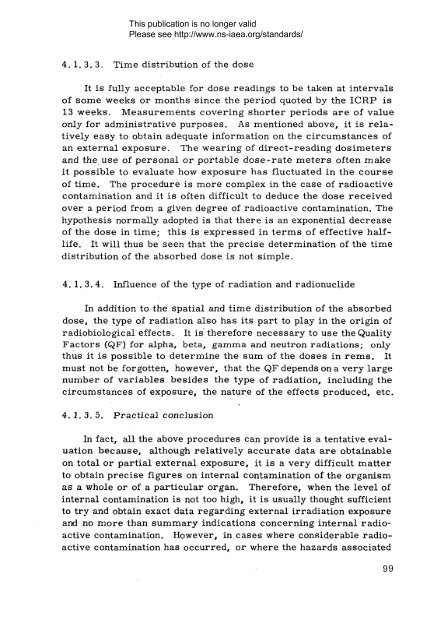Safety_Series_025_1968 - gnssn - International Atomic Energy ...
Safety_Series_025_1968 - gnssn - International Atomic Energy ...
Safety_Series_025_1968 - gnssn - International Atomic Energy ...
You also want an ePaper? Increase the reach of your titles
YUMPU automatically turns print PDFs into web optimized ePapers that Google loves.
This publication is no longer validPlease see http://www.ns-iaea.org/standards/4. 1. 3. 3. Time distribution of the doseIt is fully acceptable for dose readings to be taken at intervalsof some weeks or months since the period quoted by the ICRP is13 weeks. Measurements covering shorter periods are of valueonly for administrative purposes. As mentioned above, it is relativelyeasy to obtain adequate information on the circumstances ofan external exposure. The wearing of direct-reading dosimetersand the use of personal or portable dose-rate meters often makeit possible to evaluate how exposure has fluctuated in the courseof time. The procedure is more complex in the case of radioactivecontamination and it is often difficult to deduce the dose receivedover a period from a given degree of radioactive contamination. Thehypothesis normally adopted is that there is an exponential decreaseof the dose in time; this is expressed in term s of effective halflife.It will thus be seen that the precise determination of the timedistribution of the absorbed dose is not simple.4. 1. 3.4. Influence of the type of radiation and radionuclideIn addition to the spatial and time distribution of the absorbeddose, the type of radiation also has its part to play in the origin ofradiobiological effects. It is therefore necessary to use the QualityFactors (QF) for alpha, beta, gamma and neutron radiations; onlythus it is possible to determine the sum of the doses in rem s. Itmust not be forgotten, however, that the QF depends on a very largenumber of variables besides the type of radiation, including thecircumstances of exposure, the nature of the effects produced, etc.4. 1. 3. 5. Practical conclusionIn fact, all the above procedures can provide is a tentative evaluationbecause, although relatively accurate data are obtainableon total or partial external exposure, it is a very difficult matterto obtain precise figures on internal contamination of the organismas a whole or of a particular organ. Therefore, when the level ofinternal contamination is not too high, it is usually thought sufficientto try and obtain exact data regarding external irradiation exposureand no more than summary indications concerning internal radioactivecontamination. However, in cases where considerable radioactivecontamination has occurred, or where the hazards associated99
















